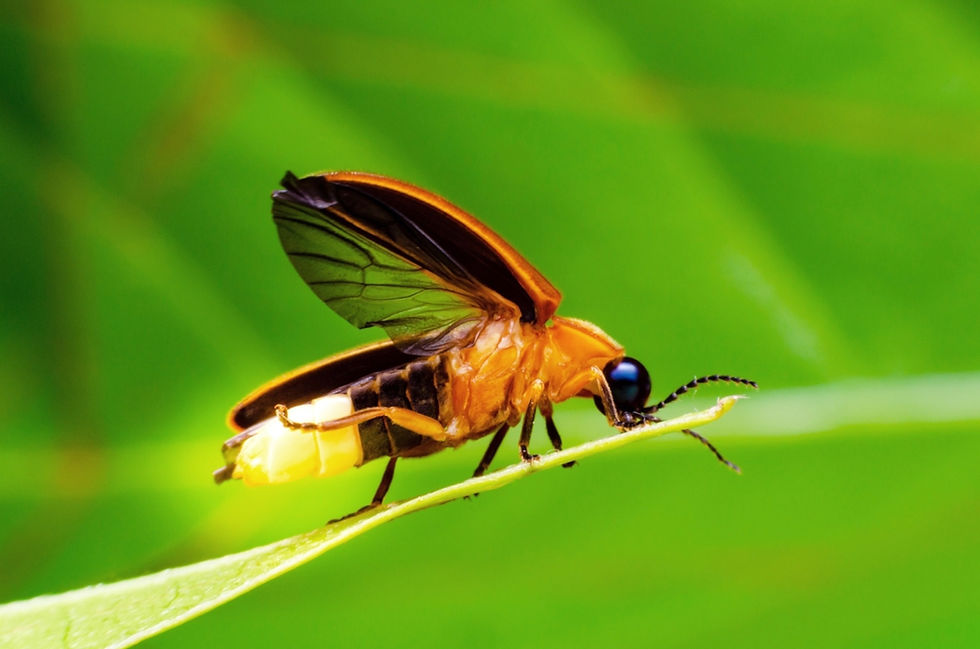Where have all the fireflies gone?
- Dr. Farrukh Chishtie

- Jul 30
- 3 min read
//
Yahya Imran
I once heard my mom talk about how she “kidnapped” fireflies in her scarf and brought them home. Then my dad chimed in and said he did the same thing — which, if you ask me, sounds like something that might get them charged with kidnapping if the fireflies could speak!

Curious about what made these glowing bugs so fascinating, I did some research. I knew they existed — I had seen them in movies — but I never really thought about them. And that’s the tragedy: I’ve never seen a firefly in real life. Not once. And I probably never will.
They’ve disappeared from most places — even the wild open spaces.
If we want to bring them back, we need to take radical action! So that our generation — and the next — can experience the same magical moments our parents did.
Why are fireflies disappearing?
There are three major reasons why fireflies have nearly vanished:
Habitat loss due to urbanization
Pesticides used in gardens and yards
Toxic chemicals polluting water bodies where many firefly species are born
Most of these problems are fixable. But first, we need to understand how fireflies are born, how they live, and what makes them disappear from a place for good.
How are fireflies born?
A male firefly flies around, flashing his light to let females know he’s looking for a mate. If a female is interested, she flashes back from her spot on the ground — and the male flies down to meet her. Depending on the species, this flashing can happen in perfect synchronization across thousands of fireflies.
But here’s the catch: when artificial lights — like streetlights, house lights, or headlights — shine in their environment, it confuses them. In one study, when a car drove by with its headlights on, the fireflies stopped flashing in sync. It took them two to five minutes to get back in rhythm.
Scientists have found that these disruptions reduce mating success. That means fewer baby fireflies are born.
After mating, the female lays her eggs in moist soil, leaf litter, or rotting logs. The eggs hatch in 2 to 3 weeks — but they don’t become glowing adult fireflies immediately. They spend the next two years as larvae underground, hunting earthworms and other insects. Firefly larvae are natural insect controllers! But this also means they’re very vulnerable — they can easily be killed before they ever light up.
We do not know enough
I had to dig through a lot of sources just to learn these facts. That’s SAD!
A 2021 study found that 11% of North American firefly species are threatened with extinction, 2% are near-threatened, and 33% are of “least concern.” But here’s the scary part: 54% are listed as “data deficient.” Scientists simply don’t have enough information to judge how they’re doing. And that’s just North America — globally, the data is even scarcer.
Fireflies have appeared in movies like A Bug’s Life, Shrek 2, Harry Potter and the Half-Blood Prince, Avatar, Moana, and How to Train Your Dragon. Their magic has inspired countless scenes. But despite all this attention, there still isn’t enough research on them.
That’s why Firefly.org encourages people to share firefly sightings. If you see one, go to their website and report it!
How to help save fireflies
Leave rotting logs and moist leaf litter in your garden — that’s their home.
Avoid killing slugs, snails, and worms — firefly larvae feed on them.
Plant native trees and shrubs, and let your grass grow longer to help the soil retain moisture.
Stop using pesticides — they kill fireflies along with other bugs.
Limit outdoor lighting. Replace harsh lights with motion sensors or red-hued bulbs that are less disruptive.
Why is preserving their habitat such a big deal?
Because people only see fireflies when they’re glowing adults — but they go through four life stages: egg, larva, pupa, and adult. That entire process can take up to two years.
That means they’re vulnerable for most of their lives. If their habitat is destroyed, paved over, polluted, or dried out, they’ll never make it to the adult stage. And we’ll never see them glow again.
Not sure what to plant to support fireflies? Ask local farmers or gardeners — especially elders. They know what used to grow before non-native plants took over. That kind of knowledge is precious and often more accurate than online advice.
If that doesn’t help, visit undeveloped lands near you — forest edges, riversides, and even abandoned fields. See what grows naturally — that’s what fireflies need.




Comments